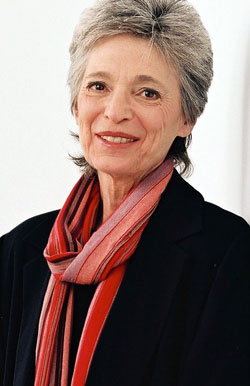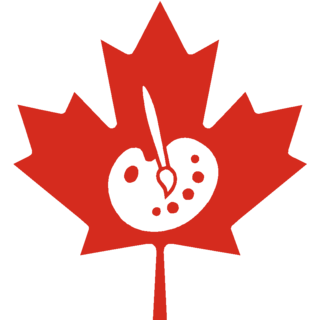
Lynne Cohen was an American-Canadian photographer.

Painters Eleven was a group of abstract artists active in Canada between 1953 and 1960. They are associated with the Abstract Expressionist movement.

Annie Pootoogook was a Canadian Inuk artist known for her pen and coloured pencil drawings. In her art, Pootoogook often portrayed the experiences of those in her community of Kinngait, in northern Canada, and memories and events from her own life.

Canadian art refers to the visual as well as plastic arts originating from the geographical area of contemporary Canada. Art in Canada is marked by thousands of years of habitation by Indigenous peoples followed by waves of immigration which included artists of European origins and subsequently by artists with heritage from countries all around the world. The nature of Canadian art reflects these diverse origins, as artists have taken their traditions and adapted these influences to reflect the reality of their lives in Canada.
Arnaud Maggs was a Canadian artist and photographer. Born in Montreal, Maggs is best known for stark portraits arranged in grid-like arrangements, which illustrate his interest in systems of identification and classification.
Jin-Me Yoon is a South Korean-born internationally active Canadian artist, who immigrated to Canada at the age of eight. She is a contemporary visual artist, utilizing performance, photography and video to explore themes of identity as it relates to citizenship, culture, ethnicity, gender, history, nationhood and sexuality.

Evergon, also known by the names of his alter-egos Celluloso Evergoni, Egon Brut, and Eve R. Gonzales, is a Canadian artist, teacher and activist. Throughout his career, his work has explored photography and its related forms, including photo-collage, instant photography, colour photocopying, and holography.
Bonnie Devine is a Serpent River Ojibwa installation artist, performance artist, sculptor, curator, and writer from Serpent River First Nation, who lives and works in Toronto, Ontario. She is currently an associate professor at OCAD University and the founding chair of its Indigenous Visual Cultural Program.
Shelley Niro is a Mohawk filmmaker and visual artist from New York and Ontario. She is known for her photographs using herself and female family members cast in contemporary positions to challenge the stereotypes and clichés of Native American women.
Colette Whiten is a sculptor, and installation and performance artist who lives and works in Toronto, Canada. Whiten is a recipient of the Governor General's Medal.
Deanna Bowen is an interdisciplinary artist whose practice includes films, video installations, performances, drawing, sculpture and photography. Her work addresses issues of trauma and memory through an investigation of personal and official histories related to slavery, migration, civil rights, and white supremacy in Canada and the United States. Bowen is a dual citizen of the US and Canada. She lives and works in Montreal.
Spring Hurlbut is a Canadian artist, known for work that deals with the relationship between sculpture and architecture, and with themes of mortality. She lives and works in Toronto.
Sandra Brewster is a Canadian visual artist based in Toronto. Her work is multidisciplinary in nature, and deals with notions of identity, representation and memory; centering Black presence in Canada.
Maria Hupfield is a Canadian artist, working in Brooklyn, New York. She is an Anishinaabe, specifically an Ojibwe and a member of the Wasauksing First Nation, located in Ontario, Canada. Hupfield works in a variety of media, including video and performance. Her performance practice references Anishinaabeg oral history and feminist performance history.
Meryl McMaster is a Canadian and Plains Cree photographer whose best-known work explores her Indigenous heritage. Based in Ottawa, McMaster frequently practices self-portraiture and portraiture to explore themes of First Nations peoples and cultural identity, and incorporates elements of performance and installation to preserve her mixed heritage and sites of cultural history in the Canadian landscape.
Angela Grauerholz D.F.A. is a German-born Canadian photographer, graphic designer and educator living in Montreal.
Pamela Edmonds is a Canadian visual and media arts curator focused on themes of decolonization and the politics of representation. She is considered an influential figure in the Black Canadian arts scene. Since 2019, Edmonds has been the senior curator of the McMaster Museum of Art.
Michelle Jacques is a Canadian curator and educator known for her expertise in combining historical and contemporary art, and for her championship of regional artists. Originally from Ontario, born in Toronto to parents of Caribbean origin, who immigrated to Canada in the 1960s, she is now based in Saskatoon, Saskatchewan.
Louise Noguchi is a Canadian multidisciplinary visual artist who uses video, photography, sculpture, and installation to examine notion of identity, perception and reality.
Sophie Hackett is the Curator of Photography at the Art Gallery of Ontario, Toronto.



